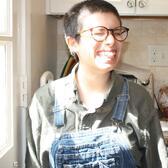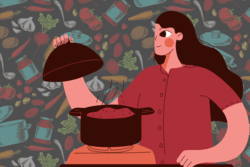Charcuterie: More Jewish Than You Think!
Charcuterie is an undeniable trend these days—my Instagram feed is full of posts from various charcuterie-related accounts, and it seems like any fancy restaurant I go to has a cheese board on its appetizer menu. Recently, the supermarket chain Aldi even appointed a Charcuterie Board of Directors. As a lifelong cheese-and-crackers enthusiast, I welcome this trend. I’m constantly accumulating boards, cheese knives, and books on pairing cheese with other foods so I can up my personal charcuterie game.
But for me, charcuterie is about much more than eating good food. I also love the design element: setting up the board so that it looks as attractive as possible and labeling different cheeses for guests. Most of all, though, I love the hosting element. A cheese board feels incomplete without a group of people to enjoy it, and I’m always looking for excuses to invite friends over so I can make one for them. I think that’s why making cheese boards has always felt a little Jewish to me—I’ve been taught to associate Judaism with hospitality and welcoming guests.
I realize, though, that charcuterie may not seem very Jewish to most people. First and foremost, because it usually involves the mixture of meat and dairy, strictly prohibited by Jewish dietary laws. As it turns out, the term charcuterie comes from the French words chair and cuit, or flesh and cooked, and the term charcutier literally means “pork butcher.” In fact, charcuterie is all about meat—its original purpose was to prepare meat in a way that preserved it before refrigeration was invented, and not to waste any parts of animals, including fat and internal organs.
But since then, charcuterie has evolved beyond its initial function. Now, I and many others think of it more as an art form, all about combining unique flavors and displaying them in unique ways. I never even use meat when I put together charcuterie boards—for me, it’s all about the cheese.
Still, I wondered if there was a way to put a distinctly Jewish spin on the charcuterie trend. Was there any basis for it in our own traditions? Were there any ways we could incorporate it into Jewish practices and rituals?
As I discovered, there are a lot of people already doing just that, like Meat and Board and Harbor Gourmet, kosher charcuterie companies from New Jersey and Florida, respectively. As Harbor Gourmet's website explains, kosher meat sometimes doesn’t react to typical charcuterie techniques in the same way as non-kosher meat, so Jewish charcutiers have had to develop their own methods and recipes to create similar finished products. Both companies also make specialized boards for holidays, and Meat and Board delivers Shabbat charcuterie boards and provides tips and tutorials on their social media accounts.
Maybe most interestingly, Meat and Board’s Instagram account also provides information about Jewish contributions to charcuterie, such as duck prosciutto, which comes from the Sephardic Jewish communities in Italy and Spain. Prosciutto, or uncooked and salt-cured ham, is a centuries-old part of Mediterranean culture, and was once essential to the preservation of charcuterie meats. References to Jews preparing salted duck and goose as an alternative to prosciutto date back to fifteenth-century Spain. Customs like this show us that the tradition of charcuterie is already more Jewish than we think.
Kosher charcuterie companies such as Meat and Board generally focus on meat (as you might be able to tell from the name). Because of this, their boards are missing my favorite part of charcuterie: the cheese. But cheese does heavily factor into some Jewish rituals, including holidays. There’s Shavuot, during which it’s customary to eat dairy products like cheesecake. There are a lot of different theories about the origins of this tradition, but some scholars trace it back to spring harvest festivals, which often included dairy dishes, since cheese was typically produced in the spring, after animals had given birth.
There is also a medieval Jewish tradition of eating wine and cheese—even more charcuterie-adjacent—on Hanukkah, most likely because of its association with the story of Judith, which is often read as an alternative Hanukkah text. In this story, Judith uses wine and cheese to gain the trust of an Assyrian general who is threatening her village, eventually leading to his defeat at her hand. Sure enough, there is plenty of cheese board-related Shavuot and Hanukkah content to be found, including charcuterie classes, guides, recipes, and tastings.
So, now we know about Jewish customs related to meat and to dairy, and how Jews have both added to the charcuterie tradition and incorporated it into their own practices. But what about arguably the defining element of charcuterie—the display of different foods on a board?
This connection might be the most obvious of all—it’s something we do every year during Passover. While reading through the numerous guides on making a perfect Shavuot or Hanukkah cheese board, I noticed that each talked about the importance of presentation, layout, and symbolism—all things that are also important to seder plates, where food is displayed in a particular manner. Cheese board guides will often recommend specific fruits, cheeses, and wines that are especially suited to the summer or winter season for symbolic or flavor-related reasons, much like how each food on a seder plate has a symbolic connection to the holiday.
Seder plates and charcuterie boards can also both get pretty ornate, and even have some similar ingredients—grapes and wine are staples of both, horseradish is a classic savory dip for crackers, and charoset is a great spread that includes nuts and fruits, which are also classic charcuterie ingredients.
Maybe not surprisingly, other people have made this connection already, and have used the components of the seder plate to create their own Passover charcuterie boards. Some make substitutions to make their boards a little more charcuterie-like, but still thematically appropriate—lamb chops instead of a shank bone, chimichurri dip to represent karpas (parsley), or deviled eggs as an upgrade from hard-boiled. Many Passover charcuterie boards also include Sephardic charoset, which combines dates and nuts and is perfect for dipping.
But Passover isn’t the only holiday that involves a seder. Probably most notably, some Sephardic and Mizrahi Jews have a Rosh Hashanah seder as well—and this one’s customary foods might be even more suited to charcuterie boards. Like Passover seders, the food eaten at Rosh Hashanah seders has symbolic meaning, generally related to good omens for the future. The foods on the plate, which include dates and figs, squash and pumpkin, chard, beets, and leeks, are called simanim, or “signs,” and are described in the Talmud as plants that grow quickly and in abundance.
The tradition has evolved, and it’s now common to also use pomegranates, string beans, chives and scallions, and, of course, apples and honey in Rosh Hashanah seders (although some people replace apples with quinces). And while a Passover charcuterie board might require a little bit of extra creativity, Rosh Hashanah foods lend themselves naturally to pairing with cheese and other customary charcuterie ingredients—and there’s no meat involved!
With the Jewish New Year only a month away, here are a few tips on building a Rosh Hashanah charcuterie board:
- Consult this list of the best apple and cheese combinations—a staple of many charcuterie boards.
- Check out this guide to pairing cheese with honey (or you can just drizzle it on brie and serve with nuts or bread, like I do).
- Figs and dates are also great to combine with cheese and honey—fresh figs and fig jams also go well with soft cheeses, while dried figs can be stuffed with cheese and nuts.
- Goat cheese and pomegranates are another classic combination and can be spread on crackers.
- Buy pumpkin seed crackers, or just roast the seeds with oil and spices and use as a topping.
- Swiss chard is a versatile green that can be paired with most things, but try using chard stems and beets to make hummus, which enhances every charcuterie board with vegetables. This charcuterie recipe also pairs it with grilled apricots.
Try out some or all of these tips next month when you invite people over for a Rosh Hashanah feast. Who knows—maybe we can make Jewish charcuterie the next big thing!







